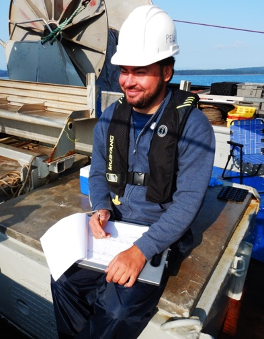WORLD JELLYFISH DAY

Florian Lüskow taking notes of CTD cast information on a research expedition around Vancouver Island in summer 2019 ©Jacob Lerner
“It became very clear to me early on that I wanted to work (and live) somehow with the water, and literally, in my first lecture on invertebrate diversity in my undergraduate, I learned about jellyfish and their kin,” said Florian Lüskow, a Ph.D. candidate at the University of British Columbia, researching marine ecology and biological oceanography.
There is much that researchers do not know about jellyfish, and they are often disregarded in marine biology and climate change discussions. With a background in biology and marine biology, Lüskow is hoping to change that. His 2021 paper focused on freshwater jellyfish in British Columbia, and highlighted an increase of sightings of these jellyfish that may be indicative of climate-change related range extensions, growing public awareness, and/or an increase in observational efforts.
Deceptively complex creatures, jellyfish can be found in most aquatic systems, from marine, brackish, and freshwater systems to polar regions, the tropics, shallow waters, and deep-sea trenches. The most diverse jellyfish groups are the hydromedusae with several thousands of species, although most of them are only a few millimetres in size. Often only living between a few weeks to a year, most jellyfish disappear from the water column as quickly as they appeared.

Helmet jellyfish in Trondheinsfjorden, Norway ©Florian Lüskow
Made of over 90 per cent water, we often expect them to be of little importance in the grand scheme of things.
“However, it is just the opposite,” said Lüskow. “Jellyfish occur in huge amounts along shorelines, and in some parts of the world, are fished for and farmed in aquacultures for human consumption. We also know that they prey directly on fish eggs and larvae, which makes them also highly important to consider for fish population dynamics.”
“Indeed, jellyfish play a vital role in connecting bottom and open water ecosystems, and many species depend on them to complete their life cycle,” Lüskow said.
Jellyfish play important roles in coastal food webs, and researchers have only started exploring their biotechnological implications for medical applications and environmental pollution research. However, there are still a lot of unknowns when it comes to jellyfish, and their effects in marine ecosystems.
“Jellyfish medusae are only the visible part of a complex life cycle. Where their polyps are, what they eat, and what else they do is, in most cases, entirely unknown,” Lüskow said. “Their indirect effects on population dynamics, shaping microbiological communities, and interactions with other non-indigenous species are often not addressed.”
So, why is there such a lack of knowledge and active research into jellyfish and gelatinous zooplankton?
“When I am on board research vessels, one thing that always draws a tired smile is when fisheries scientists have the perception that marine jellyfish are nuisances to marine ecosystems. After processing target species in fisheries trawls, I am often told to ‘enjoy the leftover slime’,” Lüskow said. “There are also only a few dozen studies that look at the ecology of freshwater jellyfish, and many critical factors need to be researched further before statements can be made about their impact on ecosystems.”

Trawl catch of helmet jellyfish in Trondheinsfjorden, Norway ©Florian Lüskow
“The impact of climate change on freshwater jellyfish populations in B.C. is a topic close to my heart, and long-term monitoring on a broad scale is the only way to address this,” Lüskow said. “Realistically speaking, over the years, I hope to assemble a dataset that will allow provincial and federal government monitoring of these creatures to become a reality.”
Other related papers
Distribution and biomass of gelatinous zooplankton in relation to an oxygen minimum zone and a shallow seamount in the Eastern Tropical North Atlantic Ocean was published in Marine Environmental Research.
Gelatinous and soft-bodied zooplankton in the Northeast Pacific Ocean: Phosphorus content and potential resilience to phosphorus limitation was published in Hydrobiologia.
Footnotes
[1] Bowen, D. (2019, November 5). The life cycle of a jellyfish: Spawning, cloning and immortality. Two Oceans Aquarium.
[2] Ibid
[3] Ibid
Tags: climate change, freshwater, IOF students, jellyfish, Marine Zooplankton and Micronekton Laboratory, Pelagic Ecosystems Lab, Research, zooplankton